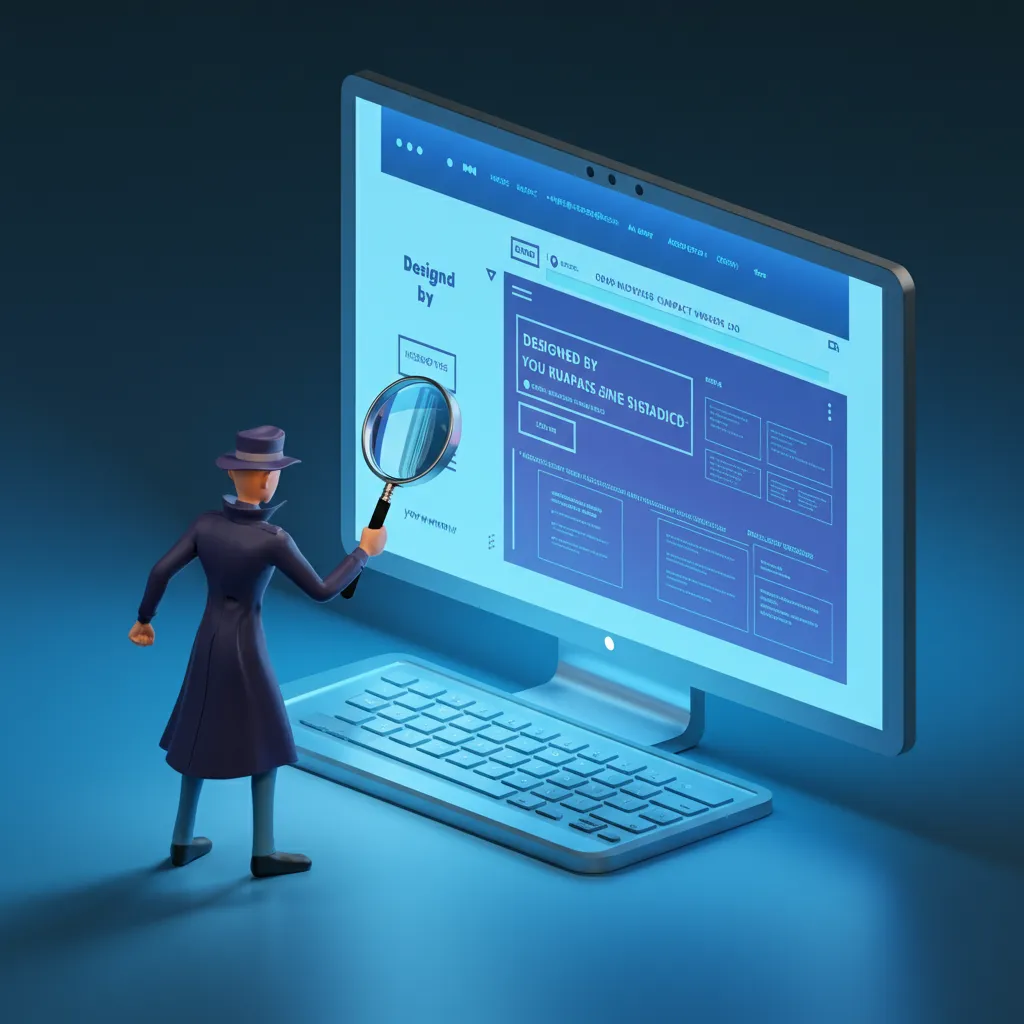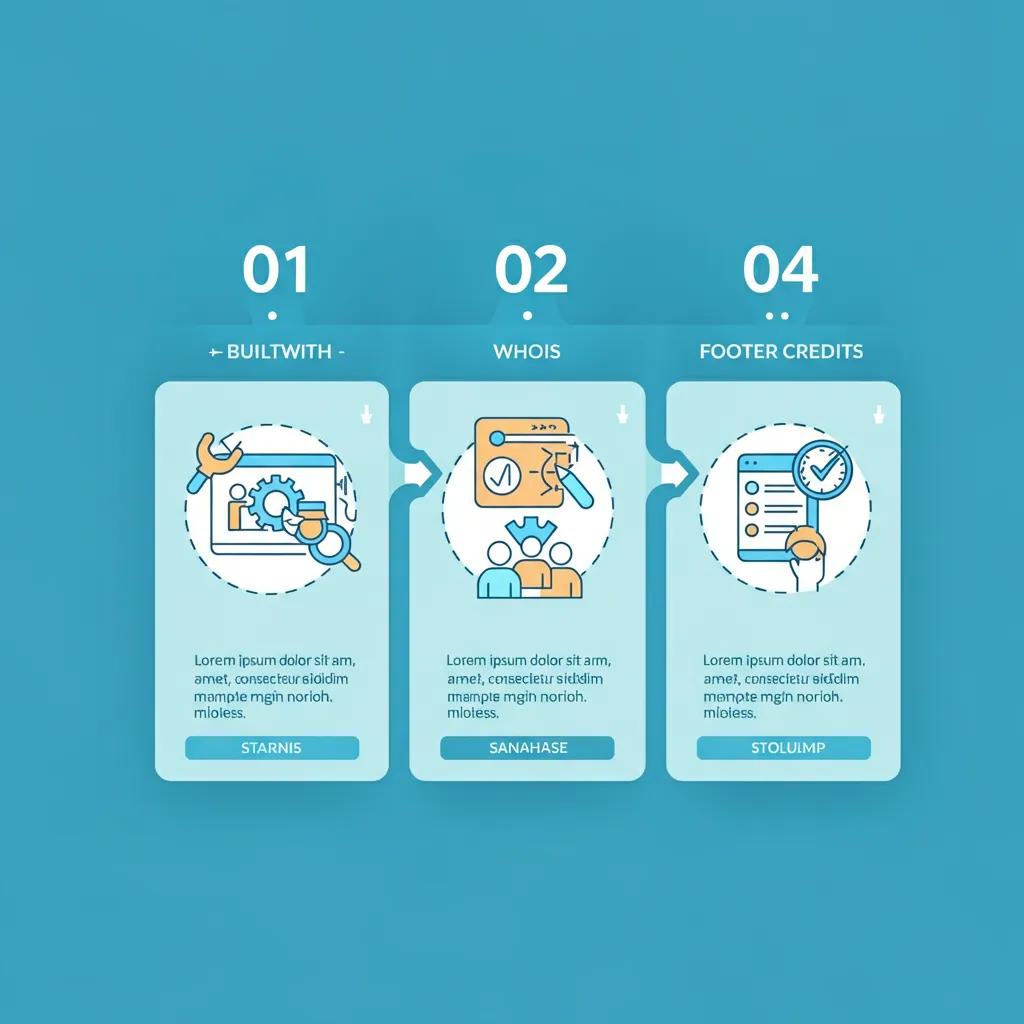Have you come across an exceptional website and wondered, “Who created this masterpiece?” You're not alone. Whether you're looking to hire the developer, learn from their techniques, or satisfy your curiosity, identifying the person or agency behind a website isn’t as difficult as it may seem.

This guide walks you through actionable and straightforward strategies to find a website developer. From exploring website footers to using tools like Whois and social media, we’ll cover every method.
Along the way, you'll also find tips to stay ethical in your search and avoid common pitfalls.
Why Would You Want to Identify a Website Developer?
Before we break down the methods, let's take a quick look at why you might want to find a website developer.
● Gaining Design Inspiration – Whether you're launching your own site or want a fresh redesign, knowing a developer's previous work can inspire your project.
● Hiring Intentions – If you loved the look and feel of a certain website, finding its developer brings you closer to hiring them.
● Addressing Website Queries – Want to address potential issues, bugs, or compliments regarding a website's design directly? You'll need the developer's details.
Now that we’ve set the stage, let’s dig into actionable ways to uncover a website’s developer.
Methods to Identify the Developer

- Check the Footer for Developer Credits
The most common and easiest place to look for developer information is the website footer. Scroll down to the very bottom—you might see something like “Designed by [Name/Agency].”
More often than not, this credit will include a clickable link that redirects you to their website.
If you don’t find any credits in the footer, don’t worry. Many developers showcase their work through other avenues.
2. Examine the HTML Source Code
Developers sometimes leave their “signature” within the website’s source code. These annotations may include comments like <!-- Developed by [Name]> or metadata related to the website’s creator.
Here’s how you can inspect the HTML code:
● Right-click anywhere on the website and select "View Page Source" (or use Ctrl+U on your keyboard).
● A new tab with the website's code will open. Press Ctrl+F to search for words like “Designed by,” “Created by,” or the developer's name.
● If you're lucky, you may find a direct reference to the developer or their agency embedded in the code.
While this method doesn't always yield results, it's worth trying for tech-savvy searchers.
3. Look for a Humans.txt File
The less-known humans.txt file can sometimes reveal information about the people who contributed to a website. This file, when implemented, lists details about the team or developer responsible for the site.
To check, simply type the following into your browser's address bar:
[website URL]/humans.txt
For instance, if the website is www.example.com, enter www.example.com/humans.txt.
If the file exists, it might include the designer or development agency's name and contact details.
4. Check the Style.css File (WordPress Websites)
If the website is built using WordPress, the theme's style.css file might contain details about the developer. To locate this file:
● Open the page's source code (as outlined in Step 2).
● Search for any mention of "style.css" within the code.
● Paste the URL for the style.css file into your browser and examine its header content for developer notes.
This method is especially useful for WordPress-based websites, as developers often include their credentials in this file.
5. Use Whois Lookup Tools
The Whois database provides public information about a domain's ownership and registration. While this won't always directly reveal the developer, it can help you identify the domain registrant's details.
Popular tools for Whois lookup include:
● ICANN
● Whois.net
Simply input the website's domain to see if any useful information is listed. Keep in mind, privacy laws or domain-protection services may prevent full details from being displayed.
6. Search for the Website in Developer Portfolios
Freelancers and web design agencies often feature their work in online portfolios. A quick Google search with terms like "website name + portfolio" or "website URL + case study" can bring up results.
Additionally, browse portfolio networks like Behance, Dribbble, or LinkedIn to track down designers. Developers are usually eager to showcase successful projects, so it's worth investigating.
7. Use a Social Media Search
Don’t underestimate the power of social platforms like LinkedIn, Instagram, or Twitter. Search for the website's name alongside terms like “web developer,” “web design,” or "created by." You may find posts or mentions that identify the creator.
On platforms like LinkedIn, look under the "employees" section to narrow your search by role (e.g., web designer, developer, etc.).
8. Ask the Website Owner Directly
If all else fails, reaching out to the website’s owner is always an option. Use the "Contact Us" page or the provided email address to send a polite and professional inquiry.
Here’s an example of a message you could write:
_"Hi [Website Owner],
I’m impressed by the design of your website and wanted to ask who developed it. I’d love to connect with them to discuss a project."_
Most website owners are happy to point you in the right direction.
Respect the owner’s decision, especially if they are unable or unwilling to share this information. Laern more about the Top Web Development Companies
Additional Tips to Strengthen Your Search
Sometimes basic methods might not yield the result you're looking for. Here are a few additional strategies to enhance your efforts.
Use Hunter.io to Track Associated Emails
A tool like Hunter.io can reveal email addresses associated with a specific domain. By identifying these email addresses, you may be able to reach out to someone connected to the site’s development.
Search for the Website in Portfolios
Web development agencies and freelancers often feature their work on their online portfolios. Try searching for the website’s name combined with terms like "portfolio" or "case study" on Google. For example:
● “site name + portfolio”
● “website URL + developed by”
Agencies frequently showcase their most successful projects, which could point you directly to the developer.
Check WordPress Style.css Files
Is the website built on WordPress? Many WordPress themes include metadata about the creator in the style.css file. To inspect this file:
1. Open the website's source code via “View Page Source.”
2. Search for "style.css" and copy its URL into your browser.
3. Review the file for clues, such as theme author or developer notes.
This method can be particularly helpful for identifying developers behind WordPress-based projects.
Privacy and Ethical Considerations
While uncovering developer details is generally harmless, it’s important to remain respectful of privacy rights. Not all website owners or developers will want to share additional information about their projects. Avoid using intrusive methods, and ensure that your efforts are ethical.
When contacting developers or the website’s owner, always:
1. Be Transparent – Clearly explain your purpose without misleading them.
2. Respect Boundaries – If someone declines to offer details, honour their privacy without insisting.
Remember, ethical interaction strengthens your professional reputation.
How to Approach Website Owners

While reaching out to website owners might feel daunting, a well-constructed message can make all the difference. Customise the tone based on your intent:
● Complimentary Approach – “I love your website design. May I ask who was behind its development? I’d like something similar.”
● Professional Request – “We’re exploring web development agencies for an upcoming project. Could you recommend your developer?”
Approaching with curiosity and professionalism builds goodwill and increases the likelihood of a positive response.
Wrapping Up
From simple methods like scanning the footer to advanced approaches using Whois tools or portfolio searches, discovering a website's developer is often manageable with the right steps. For the best results, combine multiple methods and maintain an ethical approach at all times.
Looking to partner with experienced web developers for your next project? Visit newweborder.co, where we provide top-tier web development and digital solutions. Let us help you transform your online presence with a website that stands out.
How to Find out who Developed a Website | FAQs
How can I find out who developed a website?
To determine who developed a website, you can start by checking the website footer for credits, such as "Designed by [Name]" or "Powered by [Company]".
You can also perform a WHOIS lookup to find registered information about the website's domain, which may include contact details for the owner or developer.
What tools can I use to identify a website developer?
Several tools can help you uncover clues about a website's development:
●BuiltWith or Wappalyzer can reveal the technologies used, which might narrow down potential developers.
● WHOIS Lookup Tools provide domain registration details that sometimes include the developer's information.
●Reverse IP Lookup Tools can show other websites hosted on the same server, hinting at the developer’s portfolio.
Can I contact the developer directly?
Yes, if the developer's contact information is publicly available, you can reach out to them directly. Look for email addresses, LinkedIn profiles, or business websites linked in the site footer or through WHOIS data. Always ensure you approach them respectfully and professionally.
What should I do if I can't find the developer?
If you can’t locate the developer through online tools or website credits, consider:
● Contacting the website owner or organisation directly to ask for their developer’s details.
● Searching the website or company on platforms like LinkedIn, where employees or contractors may be listed.
If all else fails, professional investigators specialising in intellectual property or digital technology might assist.
Are there any legal considerations when reaching out to a website developer?
Yes, there are legal considerations to keep in mind:
● Avoid infringing on privacy laws by using data obtained through unofficial or dubious means.
● Be courteous and avoid violating anti-spam regulations when contacting someone.
● Ensure your outreach complies with local and international communication laws, especially GDPR if dealing with EU subjects.
Looking for top-tier web development services? Explore New Web Order and partner with professionals who can help bring your project vision to life!


